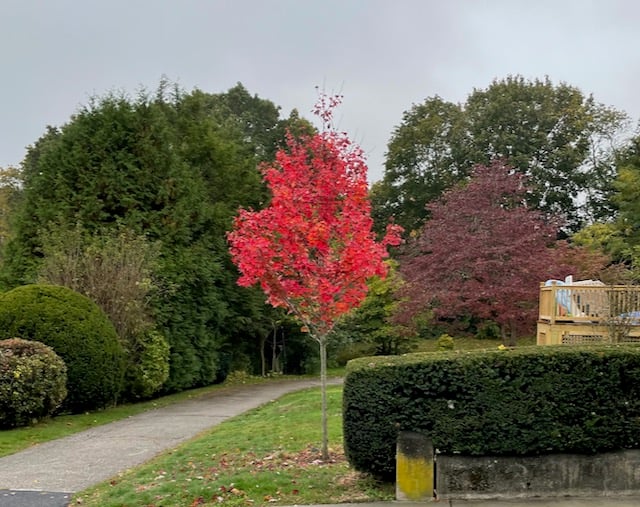Above: An Acer rubrum red maple on Greene Street planted by the EG Tree Council.
By George D. Christie
“Red Maple is the light that brightens the fall color sky throughout the northern, midwestern and northeastern states,”
– Michael Dirr, Manual of Wood Landscape Plants
My name is George. Short, easy and the vast majority of the time unique to the group of people in question. I’ve never had to be “Big George” or “George C” or anything like that. But there are a whole host of names for which that isn’t true, as the Bobs and Marys of the world can attest. Red Maples, I was surprised to discover, fit into this category as well.
Last month I talked about the importance of labels when it comes to finding true native plants. This month I’m back to the label name, but more informally, having learned the hard way (“That’s not what I meant!”) that people have different ideas of what a red maple is. To me it has always been Acer rubrum, the classic forest shade tree of eastern North America. Bright red flowers in spring and bright yellow to red foliage in the fall, its graceful form seems to appear in upland and lowland woods alike, at the edge of wetlands and in drier wood lots. And, unlike chestnut, American elm, hemlock and now beech, it seems relatively impervious to the pests and diseases humanity has imported to devastate our native forests.
Not so for many others. To them a “red maple” is a Japanese cut-leaf maple, the upright or weeping forms of which are near-ubiquitous decorations in New England yards. And for good reason, Acer palmatum (and several other species), has been cultivated for centuries in the Far East and for nearly two hundred years here in North America. Coming in a variety of colors and forms, you can almost always find one that fits a suburban landscaping need, from weeping forms overhanging fieldstone retaining walls to upright dwarf forms that grace the entry ways of houses big and small. I must admit we had one as well, arching over a rock outcrop at our last house where it was as beautiful as could be, and as foreign.
Even more surprising to me were those people who came to the garden center looking for a “red maple” and meant that massive horror known as the Crimson King. Acer platanoides, Norway maple, does hold a fond place in my heart. We had several of them in out back yard when I was a child in Delaware in the 1950’s and -60’s. Prior to the arrival of air conditioning, the coolest place in house or yard in August was often under the shade of the Norway maples. We’d run around with frisbees, hula hoops and wiffle balls until someone turned on the hose and we all got wet and, finally, were issued PB&J sandwiches and cups of lemonade. We made our way up to the maples where we tried to figure out what could be done with a Delaware August afternoon, when there seemed to be no chance of getting stuffed onto the plastic coated back seat of the car and taken to the pool.
So, I should love Norway maples. I do not. Someone at some point discovered a “red” form (actually a deep maroon), named it “Crimson King,” and sent it out into the New England landscape to deaden the view with its somber discoloration and produce thousands of baby trees, none of which are maroon and all of which displace native plants and animals. Because local wildlife avoids Norway maples like the plague. As Doug Tallamy writes in Bringing Nature Home, “Well into its third century of residence [in North America], the growth and reproduction of Norway maples is still influenced little or not at all by organism native to this country.” Furthermore, unlike the equally nonnative Japanese maples, Norway maples get huge, engulfing with their disconnected mass large volumes of space where caterpillars, and hence birds, will find no food. A robin may nest in one, to be sure, but only if native trees, like Acer rubrum, are nearby.
For me the name “red maple” will remain reserved for the glorious native Acer rubrum, the only red maple we should be planting here in New England. I suppose a small Japanese maple does little enough harm, even Tallamy admits a few non-natives don’t materially detract from the value of a landscape planted primarily with natives, but there can be little excuse for Norway maples in New England. Let them be beautiful in the Eurasian forests where they came to be. Every one planted there means life to the creatures who have lived with it for thousands of years. Every one planted here means loss to the creatures who, even after 300 years, have no idea what this thing is.
George Christie, formally trained in entomology and landscape architecture, has worked in mosquito control, environmental education and garden design and plant sales. He currently works for the Rhode Island Natural History Survey managing their rare species database.






 Subscribe
Subscribe
Absolutely love my acer rubrum maple. I too have a Norway maple in my yard that while it provides lots of shade, does nothing for wildlife. It seems to be coming to the end of its life as many big branches have fallen. When thay day comes, I can’t wait to plant another red maple or another native tree. Other than a red maple, what other native trees do you like & recommend?
Hi Heather, Any native oak (Quercus alba, Q. coccinea, Q. rubra) is a great choice. Betula nigra (river birch) is another good choice, though you’ll probably have to settle for a cultivar (‘Heritage’ is the most common). For smaller trees Oxydendron arboreum (sourwood) and Cercis canadensis (American Redbud) and Cornus (Swida) alternifolia (Pagoda dogwood) are very nice. Redbud cultivars are easy to find, Pagoda dogwood and Sourwood are more difficult. Cornus florida, our native dogwood is beautiful and most cultivars on the market today are disease resistant (‘Cherokee’ series, for example). Avoid the dreaded Kousa dogwoods and the Rutgers hybrids–both are pretty, but function as plastic popsicles as far as wildlife is concerned.
The friendly folk at Wildwood (local business plug here folks!) can help source straight species for most of these. If they can’t, I recommend Garden in the Woods (Native Plant Trust) in Framingham, MA as your best bet (~1:20 by car from EG). Try their plant finder for more ideas.
https://plantfinder.nativeplanttrust.org/Plant-Search
Sadly, most trees on the market today have had their leaders cut to encourage bushier plants (trees are supposed to look like bushes?) which are more attractive to people who don’t know trees. Not much can be done there. They’ll be fine for decades, most likely, they’ll just be oddly shaped compared to their woodland counterparts.
Added bonus from the red maple: Syrup. I have two red maples which I tap every year, right in my backyard.
Hey Kevi,
Glad to hear it!
Thanks for these enlightening articles George. Somewhere I had gotten the mistaken impression that the red maple was a Chinese import. It’s nice to know that they are native and have the added bonus of disease resistance.
I think because so many people call the Japanese cut-leaf maples “red” maples, so it gets confusing. That’s why we try to use scientific names when we can, though they can get confusing too. Cornus alternifolia is now officially Swida alternifolia which isn’t too bad but Cornus canadensis (bunchberry) is now Chamaepericlymenum canadense, which is functionally unpronounceable.